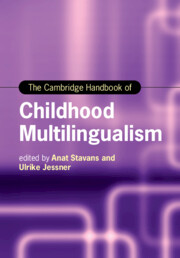Book contents
- The Cambridge Handbook of Childhood Multilingualism
- Cambridge Handbooks in Language and Linguistics
- The Cambridge Handbook of Childhood Multilingualism
- Copyright page
- Contents
- Figures
- Tables
- About the Editors
- Contributors
- Acknowledgments
- Multilingualism Is Not Bilingualism +1: An Introduction
- Part One Becoming and Being a Multilingual Child
- Part Two Cognition and Faculties in Multilinguals
- 5 Language and Thought in Multilingual Children
- 6 Multilingual Exposure and Children’s Effective Communication
- 7 Metalinguistic Awareness and Early Multilingual Learning
- 8 Code-Switching among Bilingual and Trilingual Children
- 9 Children’s Perception of Their Multilingualism
- 10 Multilingualism and Language Play
- Part Three Family Language Policy
- Part Four Language(s) and Literacy of Multilingual Children through Schooling
- Part Five Socialization in Childhood Multilingualism
- Part Six Multilingual Children’s Landscape
- Subject Index
- Country Index
- Language Index
- References
9 - Children’s Perception of Their Multilingualism
from Part Two - Cognition and Faculties in Multilinguals
Published online by Cambridge University Press: 18 August 2022
- The Cambridge Handbook of Childhood Multilingualism
- Cambridge Handbooks in Language and Linguistics
- The Cambridge Handbook of Childhood Multilingualism
- Copyright page
- Contents
- Figures
- Tables
- About the Editors
- Contributors
- Acknowledgments
- Multilingualism Is Not Bilingualism +1: An Introduction
- Part One Becoming and Being a Multilingual Child
- Part Two Cognition and Faculties in Multilinguals
- 5 Language and Thought in Multilingual Children
- 6 Multilingual Exposure and Children’s Effective Communication
- 7 Metalinguistic Awareness and Early Multilingual Learning
- 8 Code-Switching among Bilingual and Trilingual Children
- 9 Children’s Perception of Their Multilingualism
- 10 Multilingualism and Language Play
- Part Three Family Language Policy
- Part Four Language(s) and Literacy of Multilingual Children through Schooling
- Part Five Socialization in Childhood Multilingualism
- Part Six Multilingual Children’s Landscape
- Subject Index
- Country Index
- Language Index
- References
Summary
This chapter deals with how children reflect upon their linguistic repertoire, their language use and their lived experience of language. It draws on art-based approaches, mainly on the presentation and discussion of children’s language portraits. Language portraits have been employed for many years in educational settings as language awareness activities, as well as in research on multilingualism, calling on multilinguals to visualize their linguistic repertoire by coloring in the template of an empty body silhouette and to comment on their drawing. A close reading of language portraits produced in different workshops by children 6 to 11 years old shows that they perceive their multilingual repertoires less in terms of competences that they ‘have’ than in terms of ‘doing’ things with language, on being able to relate with others and position themselves with regard to established, sometimes competing language ideologies present in their immediate environment.
- Type
- Chapter
- Information
- The Cambridge Handbook of Childhood Multilingualism , pp. 215 - 234Publisher: Cambridge University PressPrint publication year: 2022

